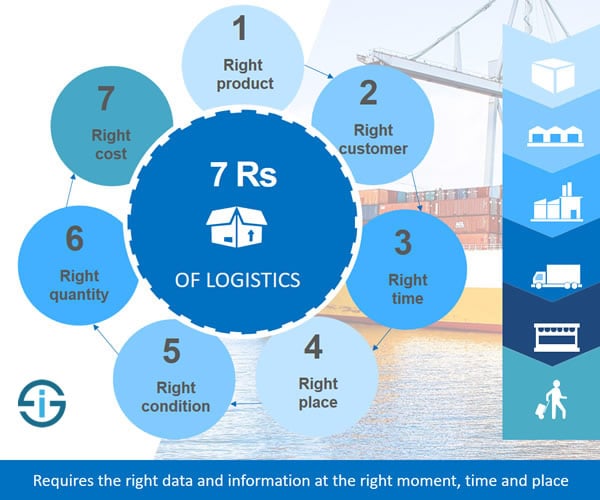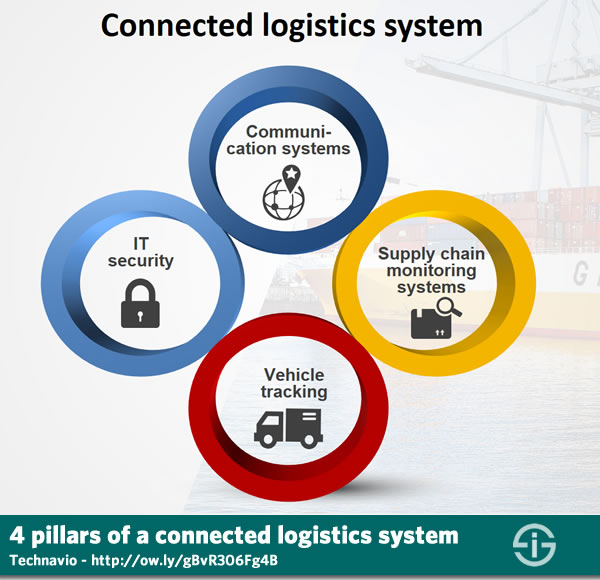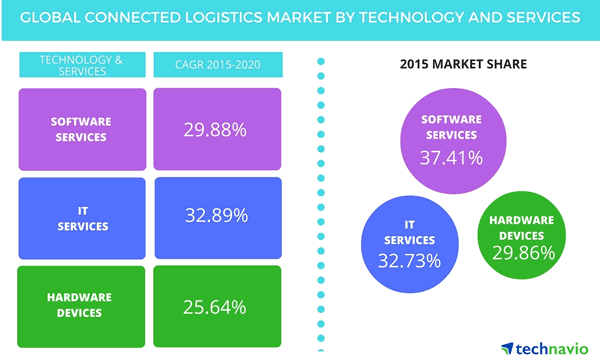Logistics, transportation and warehousing (supply chain management overall) are traditionally among the first movers in the space of connected devices which can sense and ‘communicate’, long before the term ‘IoT‘ even was coined, and closely related to Industry 4.0.
With RFID and other connected logistics possibilities, the logistics market tries to build competitive benefits in a world where speed matters more than ever.
The global connected logistics market 2016-2020: growth at a CAGR of close to 30%.
As getting the right product to the right customer at the right time, right place and right condition in the right quantity and at the right cost (the famous 7Rs of logistics), is increasingly a challenge, the logistics industry keeps investing in connected logistics solutions, strongly powered by the Industrial IoT, where it represents the second largest industry from a spending perspective, only preceded by manufacturing.

The place of the Internet of Things in the 4 pillars of a connected logistics system
According to the global connected logistics market report 2016, announced on November 28, by Technavio, the global connected logistics market is expected to grow at a Compound Annual Growth Rate (CAGR) of approximately 30 percent until 2020.
Obviously the connected logistics market isn’t just about the Industrial Internet of Things in the strictest sense but about the overall ecosystem which we typically see in an integrated Internet of Everything approach. So, it also consists of services, security, the cloud, big data analysis and several other third platform technologies.
In fact, for Technavio, a connected logistics system has four pillars: communication systems, supply chain monitoring systems, vehicle tracking, and cybersecurity.

Nevertheless, it’s clear that the Internet of Things and, overall, the Industrial Internet, plays a significant role.
As the lead analyst at Technavio for logistics research, Sharan Ray, puts it: “The global connected logistics market is experiencing significant growth. The use of advanced IT solutions such as Internet of Things, Big Data analytics, cloud computing, and remote temperature monitoring systems have revamped logistics services.”
The connected logistics market: forecasts and evolutions per segment
The report distinguishes between three key segments, each with their own expected growth rates.
Software services
As the illustration by Technavio below indicates, software services accounted for 37.41 percent of the total market in 2015 and is poised to grow at a CAGR of 29.88 percent until 2020.
The software services segment includes both ‘connected logistics’ cloud and on-premise solutions, which can be integrated with logistics applications and ERP (Enterprise Resource Planning). It’s clear that, just as in the case in virtually all industries, there is a shift towards the cloud computing model and intelligent systems such as intelligent ERP.
Hardware devices
The hardware devices segment accounted for 29.86 percent of the global connected logistics market in 2015 and is expected to grow with a CAGR of 25.64 percent until 2020.
Here we find RFID (radio frequency identification) sensors (the sensor market evolutions are, among others driven by increasing automation), the smart connected devices of the IoT but also the inevitable communication and networking devices such as routers, switches and wireless communication devices, along with biometric devices, fleet management devices, vehicle telematics and more hardware that is needed in the scope of a connected logistics approach.
IT services
We saved the best for last. While in 2015, IT services ranked second, after software services, with a total spending share of 32.73 percent, the IT services part will be the biggest growing segment until 2020 with a CAGR of 32.89 percent.
This is also in line with what we see in many industries where services become increasingly important as organizations focus on digital transformation, innovation and optimization, shifting their spends and also IT approaches.
Advanced communication systems embedded with RFID, sensor devices, and powered by IoT help enterprises to move up the value chain
In the IT services segment we, for instance, find system integration services, consultation services, IT support and maintenance services, and application management services, which are all used extensively in the connected logistics market as the announcement of the report indicates. There is a big role for system integration services.
Existing IT systems need to be integrated with new IT systems for the seamless data and information exchanges that are enabled by the Internet of Things and key in a digital transformation economy where legacy IT often stands in the way.

Technavio’s Sharan Ray comments: “Consulting services are mated with IT planning to enhance the performance of the technologies deployed in connected logistic services. Application management services manage the enterprise application on mobile devices for the remote tracking system. Finally, IT support services manage the end-to-end IT systems used throughout the supply chain.”
According to the summary page of the report the leaders in the global connected logistics market are Accenture, AT&T, Cisco, SAP, and Oracle.
A driver of IoT and smart solutions in logistics: reducing waste by better managing temperature-sensitive products
One of the drivers of market growth and of the increasing use of the Internet of Things and smart applications is the growing demand for possibilities to effectively manage temperature-sensitive products and, along with that, the high rates of waste.
In the press release, Technavio gives the well-known example of logistics (shipping) giant Maersk Group, who has implemented Industrial IoT solutions, provided by AT&T, to manage their refrigerated containers.
This way, Technavio says, advanced communication systems embedded with RFID, sensor devices, and powered by IoT are helping enterprises to move up the value chain.
The future of the global connected logistics market is clearly IoT, integrated solutions, data and, last but not least, mobility.
From the report’s landing page: “The increasing innovations in mobile technology will fuel the growth prospects for the global connected logistics market until the end of 2020. Enterprises…are increasingly using mobile technologies to manage their supply chain management (SCM) and distribution systems.”

